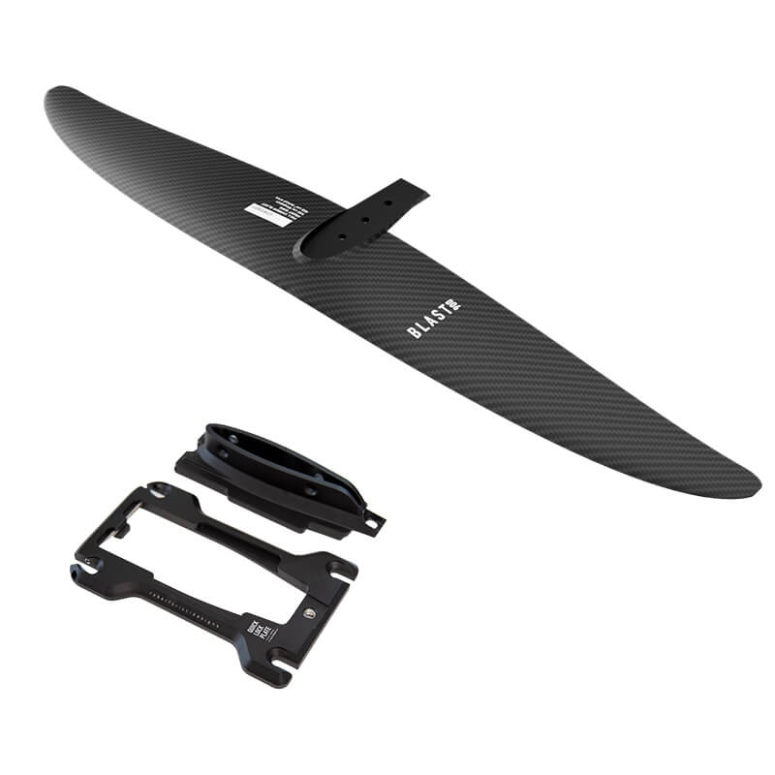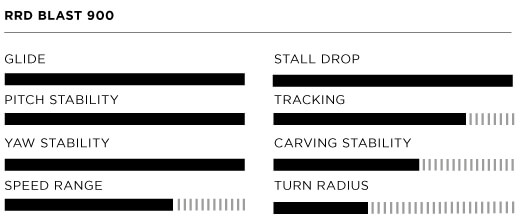

When you purchase gear through links on our site, we may earn a small commission. Here’s why you can trust our tests and our affiliate partner.

RRD has expanded their modular foil system for 2023 and has added to the performance end of their offerings with their Dynamic Pro, Blaze, Spark and Blast foils. We’ve already tested the Blaze 1250 and Spark 900 which both impressed on the speed and performance front thanks to their thinner foil sections. The Blast is no different and sits in the high aspect ratio category along with the Spark. Interestingly the Spark (AR 9) and the Blast (AR 10) both come in 900cm2 sizes. Whilst the Spark is designed for powered winging, freestyle and wave riding (also evident in its availability in smaller sizes), the Blast is made with efficiency in mind and is the foil of choice for many of RRD’s riders when racing in lighter wind conditions.
This Blast was tested with the 85cm aluminum mast (combined with the RRD Quicklock baseplate), 66cm fuse and 195 Blaze rear wing. The assembly of the foil is straightforward, and as noted in previous reviews of other foils in RRD’s range, the whole system is incredibly stiff, allowing, the rider a direct connection to the foil. One observation worth noting is that RRD have ensured that all bolts (with the exception of the optional barrel nuts on the fuselage) are M8 therefore only requiring a single tool for assembly. Comparing the Blast to the Spark, the Blast has a higher aspect ratio meaning it has a slightly wider span. Shape wise, the Blast has a negative dihedral shape which allows the foil to roll over nicely into turns. A very thin foil section again ties into the theme of efficiency and really aims to minimize the drag of the foil.
Getting started with the Blast does require a bit of finesse due to the higher AR (RRD does recommend it as a foil for advanced level riders). However, with good pitch management, the foil has a good low end. Once up, even in lighter conditions, the Blast is very quick with little drag, allowing the rider to benefit from the apparent wind generated. The foil holds its course well and lets you cut hard upwind effortlessly. In turns the Blast has a slightly wider turning radius, as a result of its span, but the shape of the foil allows you to roll the foil over effortlessly and lock into wider drawn out carves as opposed to hard snaps. This makes the Blast better suited for slightly bigger mellower waves or open ocean bumps where you have the space for these types of turns. The Blast provides a comfortable amount of front foot pressure and feedback which helps you feel the energy in the water as you ride. This is especially useful when downwinding, something that this foil excels in. Thanks to the efficiency of the foil, it’s possible to let go of the wing and just cruise from bump to bump with even the most minimal of bumps providing enough energy to continue gliding. Connecting bumps is effortless thanks to the easy pumping characteristics and speed range of the foil. The Blast is especially well suited to ocean downwinding, where the mix of wind bumps and longer period swells require a foil with a wide speed range to be able to tap into the energy that is available.
All in all the Blast 900 is well suited for anyone looking for a foil that provides performance and efficiency on lighter wind days thanks to its wide speed range and glide. It is well suited to course racing thanks to its upwind ability and efficiency on foil and additionally doubles as a great option for downwinding.
RRD’s Quicklock plate system aims to get you on the water as soon as possible without the hassle of remembering where to put your mast (or putting it in the wrong place) using an innovative single screw system. We tested the Quicklock base plate with the Blaze, Blast and Spark foils quite extensively and when riding there really was no distinguishing between the feel of a normal base plate or the Quicklock plate. Setting your mast up on the board the first time is just like normal, using a conventional base plate that allows you to adjust and tune your mast position in the boxes. Once dialed however, a single screw allows you to undo the mast from the base plate and pivot it out of the base plate to pack away until your next session.
The system utilizes a decent sized footprint for the mast foot within the base plate with the mast foot engaging into a rail before pivoting into the base plate (from the front of the board, meaning that the forces from riding the foil act to help lock the mast in). The mast foot fits into the baseplate in such a way that there is no play in the mast with the width of the rail giving a solid base to eliminate lateral play and the lip at the front in the base plate combined with the M8 securing screw ensures there is no axial play. JM
